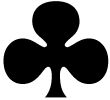And Now for Diamonds
|
 A K J 10 A K J 10 |
|
 K Q J 4 K Q J 4 |
|
 K J K J |
|
 A K 3 A K 3 |
 5 2 5 2 |
|
 9 8 6 4 9 8 6 4 |
 A 5 3 A 5 3 |
|
 10 8 7 6 2 10 8 7 6 2 |
 9 6 3 9 6 3 |
|
 A 8 2 A 8 2 |
 J 10 8 7 4 J 10 8 7 4 |
|
 6 6 |
|
 Q 7 3 Q 7 3 |
|
|
 9 9 |
|
|
 Q 10 7 5 4 Q 10 7 5 4 |
|
|
 Q 9 5 2 Q 9 5 2 |
|
The one is too obvious to merit much discussion. You can see at a glance that you've gotta lose two aces in diamonds, while in no trump -- you've gotta lose two aces! So which is more where it counts? Indeed, there isn't even a particularly good diamond suit here, so there's little excuse for choosing diamonds over no trump.
Actually, only two people were in 5 diamonds for an inferior score with overtricks available, nay, unavoidable, in no trump, but at least they beat the 5 people in slam, while one pair passed the hand out! But if nobody bid and made 6 no trump, no fewer than eleven people made 12 tricks in three no! Now wait a minute. Even if the person with the ace of diamonds doesn't find the heart shift, declarer still has only 11 winners without recourse to the heart suit, doesn't he? Well, now . .
One can only presume that West ducked a low lead to dummy's heart honors. Was this before or after the A of diamonds is knocked out? If the former, then East failed to find the heart switch, and if the latter, West failed to make certain the defense took a second trick -- which isn't too rare in a game contract where the defense is thinking of beating it, not of preventing a third overtrick.